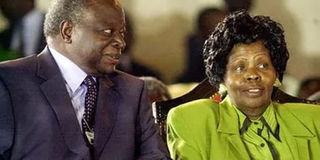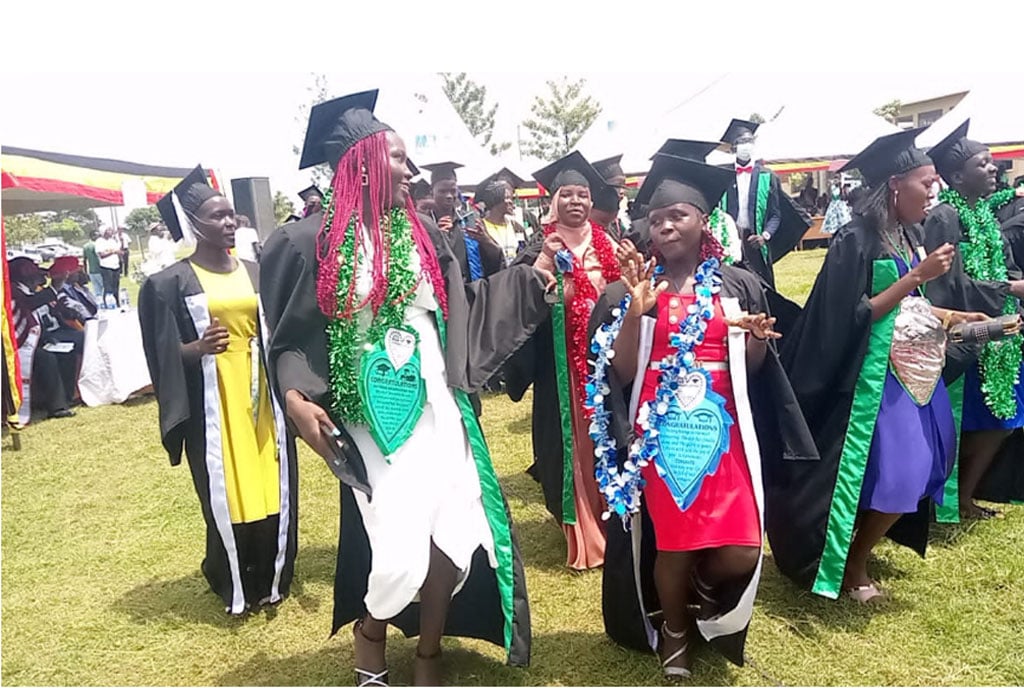Prime
Kenya wakes to news of Lucy Kibaki death

Lucy met her husband Mwai Kibaki in 1960 before the two tied the knot in 1962.
What you need to know:
Outstanding. As First Lady, Lucy was a flamboyant public figure.
Nairobi. As First Lady, Mama Lucy Kibaki, who died in London’s Bupa Cromwell Hospital yesterday, evoked fear and embodied radiance in equal measure.
During her tenure as a State House tenant, she often cut the image of an abrasive woman who was easily charged and quite unpredictable. At other times, she was the mother figure, easy with children and at ease with the public.
While Kenya’s first First Lady, Mama Ngina Kenyatta, was overshadowed by the larger-than-life profile and charisma of her husband, Mzee Jomo Kenyatta, Mrs Kibaki entered the scene with a bang after 24 years of president Daniel arap Moi’s rule, during which there was no First Lady. Mr Moi had divorced his wife Lena in the mid 1970s. As such, Mrs Kibaki had no predecessor to emulate once inside State House. At times, she goofed and at others she became a darling of the public. She had two different sides.
The former First Lady found herself in the limelight by default. President Mwai Kibaki had won the presidency in 2002 after signing a Memorandum of Understanding with a faction of Kanu then led by the party’s secretary-general, Mr Raila Odinga. No sooner had the Kibaki-Raila coalition — Narc — won the election than a fall-out occurred over State appointments. At the time, the then First Lady took it upon herself to protect president Kibaki, who was still nursing a broken leg after a road accident he was involved in during the election campaigns. Mrs Kibaki believed that she had a duty to protect her husband’s image and presidency.
Those close to her said that there were two people she detested most: Former Kabete MP Paul Muite and former Imenti Central MP Gitobu Imanyara. Mr Imanyara would later pay when the two met in State House and the First Lady slapped him. He threatened to sue her.
Inside State House, the First Lady’s word was law. Due to her temperament, many civil servants found working with her unnerving. It also made her the subject of satirists and editorial cartoonists.
With time, Mrs Kibaki became a defining figure of the Kibaki presidency as a vigilant guardian. However, of controversies that stalked her, some unwarranted, like the night raid at the Nation Centre in 2005, overshadowed her profile as the mother of the nation.
Born Lucy Muthoni Kagai in the 1940s, Lucy was the daughter of the Rev John Kagai and Mrs Rose Nyachomba – a former pastor of the Presbyterian Church of East Africa in Nyeri’s Muhito Parish. Her mother was buried at Muhito, where she was a pioneer Woman’s Guild member.
When she entered the public limelight, Mrs Kibaki’s handlers wanted her to redefine the role of a First Lady by becoming an advocate for the campaign to reduce the spread of HIV/Aids and care for those living with the disease. Also, they wanted the office of the First Lady to be substantive. However, though an office had been set up at the NSSF building in Nairobi, she hardly worked from there. The much she did on the campaign was the 2003 launch of the Kenya Chapter of the Organisation of African First Ladies against HIV/Aids (OAFLA).
While her role was to advocate for increased awareness and mobilise resources to fight HIV/Aids at the national, regional and international level, she did little on that front and her website, part of the State House web page, had few updates.
The young Lucy had attended Alliance Girls’ High School before training as a teacher. She first taught at Kamwenja Teachers’ College before she was transferred to Kambui College, now known as Kambui Girls, where she got to know Mr Kibaki – then the Kanu executive officer. At the time, Mr Kibaki was establishing grassroot branches for the independence party.
Lucy was petit, stylish and loved gigs. Her early pictures show that she not only evoked radiance but was photogenic too.
Inside State House, she started the State House choir, a rather successful outfit that entertained guests during national events. The last time she appeared in public, during the promulgation of the new Constitution, she surprised everyone by standing up and dancing to the tune of Emmy Kosgey’s Taunet Nelel.
After that, she retreated to her Muthaiga home and skipped all State functions, including the farewell party for president Kibaki – a man whose political career was partly tied to the moral support she gave him. Her eldest daughter, Judy, represented her.
Lucy had met the then 28-year-old Kibaki after he had abandoned his lecturing career at Makerere University and opted for a political life. Initially, Mr Kibaki had been approached by a beer distributor, Mr Njenga Karume, to become the chairman of East Africa Breweries. He turned down the offer and took another political assignment to organise Kanu.
During one of his recruitment assignments, Mr Kibaki met Lucy at Kambui. He was with Mr John Keen (later Mr Kibaki’s Secretary-General in the Democratic Party). Dates between Mr Kibaki and Lucy would be organised at either the APS Quarters near Githunguri Town or at the Kiambu Golf Club, which the District Commissioner had allowed them to patronise.
Kibaki was then living in Eastlands, which provided housing for the African political elite at the time.
After they married, Lucy quit her teaching job after Kibaki won the Donholm parliamentary seat in Nairobi. This allowed her to raise her young family while also concentrating on family businesses. She was a permanent face during national events and was always at Mr Kibaki’s side during official engagements in Nairobi and at times abroad. She was always at the airport with her children to receive Mr Kibaki whenever he returned from official duties abroad.
For many years Mrs Kibaki undertook grassroots campaigns and was the patron of several women’s groups in Othaya, where she also earned respect as a tea farmer. In those days, the press hardly bothered her, until she emerged after the formation of the Democratic party (DP) in 1991 and started appearing during Mr Kibaki’s presidential campaigns, clenching the DP fist salute – perhaps with more vigour than the presidential candidate himself.
Close friends of Mr Kibaki described Mrs Kibaki as the bedrock of his political career.
“To be in leadership, you need that kind of back-up. She has raised a very good family for the president. I think she is a first class lady,” Dr Joe Wanjui says in Kibaki’s photo-biography, 50 Years of National Service. “I have a lot of admiration for her and I like her courage. She is a no nonsense lady”.
Mrs Kibaki fitted well within the DP structure, a conglomeration of elites brought together largely by wealth. DP was also the safe house for conservative politicians, those who eschewed the right-wing politics of the opposition Forum for the Restoration of Democracy (Ford). However, after Mr Kibaki’s defeat in the 1992, Lucy disappeared from the limelight, only to re-emerge during the campaigns for the 1997 elections.
Her emergence during the Narc campaigns ahead of the 2002 elections, coupled with Mr Kibaki’s victory in the presidential race, created another strong pillar at State House. However, what was anticipated to be a smooth ride was complicated by the emergence of the Narc activist, Ms Mary Wambui, who publicly claimed to be Mr Kibaki’s second wife.
President Kibaki’s first term was complicated by ill health and incessant wrangles within the National Rainbow Coalition after its Liberal Democratic Party wing — led by Mr Raila Odinga — felt shortchanged in the distribution of Cabinet posts. During that time, Mrs Kibaki became Narc’s fervent defender. Few wanted to cross her path and when she fell out with State House comptroller Matere Keriri, he had to leave.
His exit came after President Kibaki’s 2003 Christmas holiday in Mombasa almost came acropper as the two camps fought for space around the President. Lucy is said to have thrown out some of the guests. So vicious was the behind-the-scenes battle that she told a public meeting on December 28, 2004, in Mombasa that she was the bridge between the President and other politicians.
It was not a statement made out of the blue. Those who understood State House politics knew it was directed at various groupings jostling for political and economic space. With time, two centres of power emerged, one around Mrs Kibaki, and the other around Ms Wambui. The Lucy camp soiled its image with the Anglo-Leasing scandal while the Wambui one found itself embroiled in the Artur Margaryan saga.
Mrs Kibaki never complained about Ms Wambui in public. Occasionally, however, she would hit out at her critics, saying she was “the most qualified and senior-most woman to talk politics”.
Ms Wambui had, in December 2003, claimed to be “Kibaki’s wife” forcing State House to clarify the composition of the President’s family on January 6, 2004. However, no action was taken against her.
Mrs Kibaki stood by the president when he called a rare press conference at State House to say he had “only one dear wife”.
She once summoned this writer to State House to explain why he was constantly writing about the two camps. The meeting was called off inside a room in State House after an urgent matter cropped up.
Those who worked with her at State House describe her as a no-nonsense First Lady but lovely to work with. Those who crossed her path tell a different story.
Biography
• Lucy Muthoni Kibaki (Born 1940-26th April 2016
• First Lady of Kenya from 2002 to 2013.
• She was born in Mukurwe-ini to the Rev John Kagai and Rose Nyachomba, in the Mount Kenya. She was educated at Alliance Girls High School, then trained as a teacher, and rose up to the post of principal in a teacher-training college in Kiambu.
• She met Mwai Kibaki in 1960. After a two-year romance, the couple married in 1962.
• They have four children: Judy Wanjiku, Jimmy Kibaki, David Kagai, and Tony Githinji. Lucy was a patron of the Kenya Girl Guides Association
How Kenyans remembered Lucy
“Heartfelt condolences on the passing on of former First Lady Lucy Kibaki. We have lost, as a country, an astute defender of women rights,” tweeted Foreign affairs Cabinet Secretary @AMB_A_Mohammed.
“I will remember Lucy Kibaki because of her campaigns on HIV & Aids back in 2003. RIP mama Lucy Kibaki,”@wanjikumugane
“I candidly remember Mama Lucy Kibaki dancing to the tune ‘Taunet Nelel’ during our Constitution inauguration at Uhuru Park,” said @CMwabili @elkanah_cheru:
“I will remember Lucy Kibaki, may she RIP, for her fight for HIV eradication. Her legacy lives” @Wairiimu
“Lucy Kibaki questioned why there were no women ministers and her husband was president. #RIPMamaLucy”
“I pay my condolences to our Fallen Hero Mama Lucy Kibaki. You fought hard for women and HIV & Aids awareness, we love you but God loves you more RIP,” tweeted @DmcDavis




